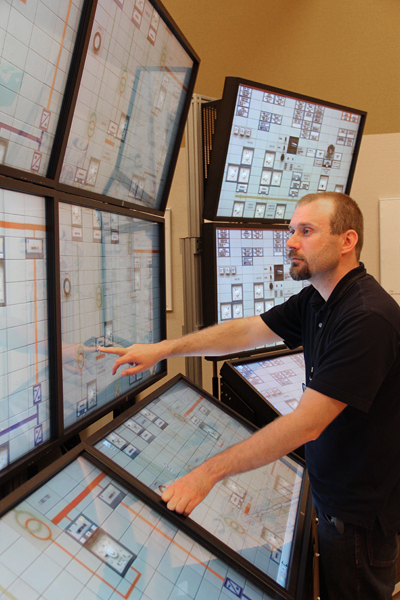Virtual panels enhance simulation efficiency
Simulator engineer Pentti Kantanen and the rest of the project team have completed the long testing period of the new virtual panels. The systems are now approved for simulator use and the development of new applications can begin.
The competence required for the operational control of a nuclear power plant unit is maintained at the plant utilising a plant-identical, full-scale simulator, which is a copy of the actual control room.
The operators and Shift Supervisors who work in the control room train various operating and transient conditions on the simulator. Having proven their competence, they all have licences that authorise them to work in the control room. The simulator makes it possible to test their competence under the most varying conditions. 
Black boxes
At the end of last year, four large black boxes were delivered to Olkiluoto and placed next to the OL1/OL2 training simulator in TVO's training centre. These "boxes", or panels, are designed to build up a second, virtual control room for the existing plant units. This new technology, which has gained popularity in the world in recent years, can be utilised to construct flexibly modifiable and cost-efficient user interfaces for training simulators.
Control with touchscreens
The panels feature touchscreens, which look like real control panels. The screen shows the control panel graphics of the control room, complete with instruments and lights. Control actions can be carried out by touching the screen, simulating the pressing of buttons on a physical panel. Functions that can be controlled include e.g. start-up and shutdown of the plant unit, starting pumps and closing valves.
– The panels form a user interface to the development simulator, which we can use for e.g. validation and development of operating instructions, testing of various modifications before they are installed in the plant, as well as precision training aside from actual simulator training. Maybe in the future it will also be possible for individual operators from our plant units to come and train of their own volition for a certain situation, for example, Pentti Kantanen clarifies.
The training simulator already features complete plant models and user interfaces for I&C systems, but the use of the simulator is restricted by the lack of the actual control room user interface, i.e. the control panels.
Training in parallel from now on
The new panels will be located in a small classroom so as to avoid any interference to the operation of the actual simulator.
– We will be able to train two groups in parallel. One using the real simulator and the other the virtual simulator. It is unlikely that the virtual control room will ever replace the actual simulator, but it opens up versatile new possibilities for training.
According to Mr. Kantanen, the panels can also be used to e.g. share video footage or different model images. Virtual execution also facilitates the implementation of changes in control room panels and development of the user interface before making any physical changes in the actual control room.
– I trust that these panels will give us a boost to the development of the actual simulator, as well, Pentti Kantanen concludes with satisfaction.
Share